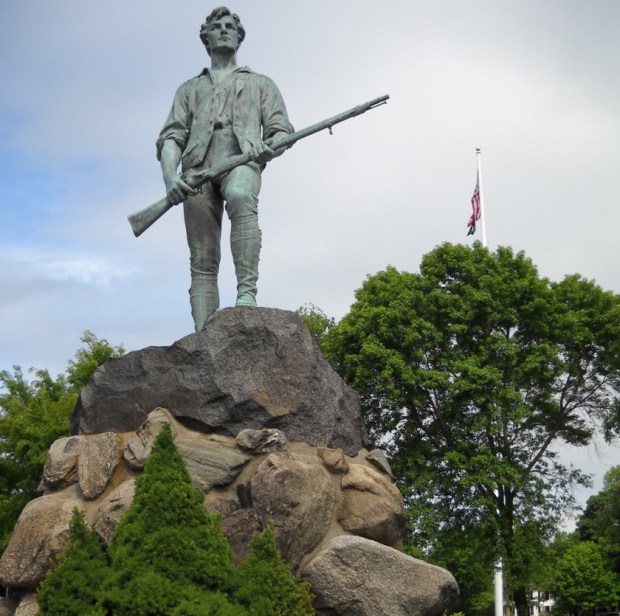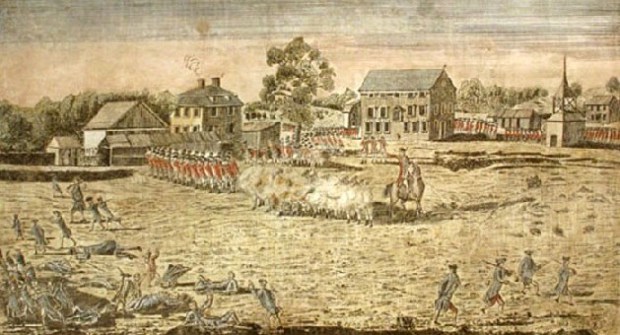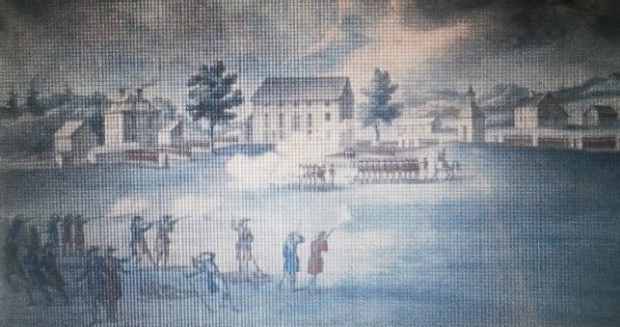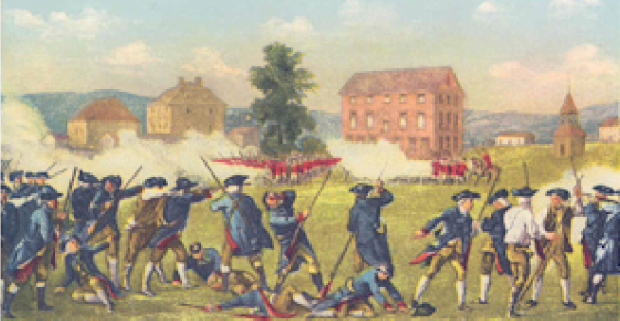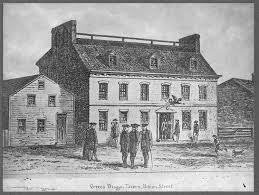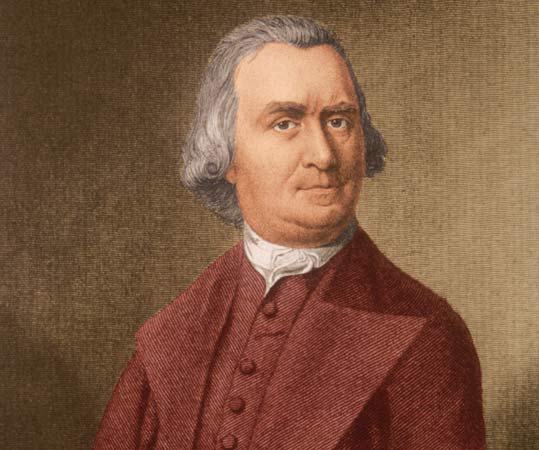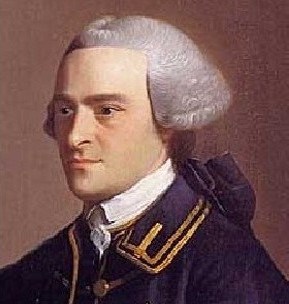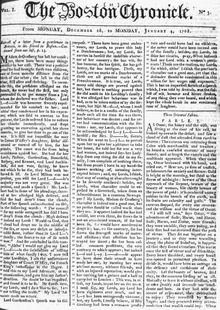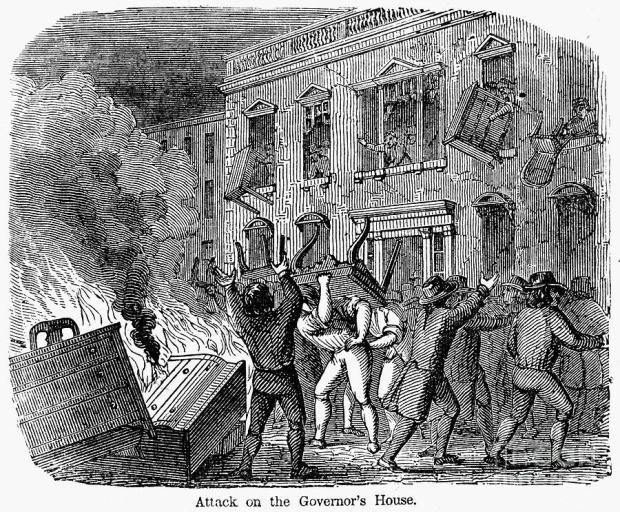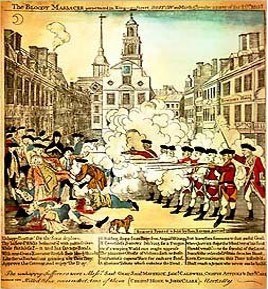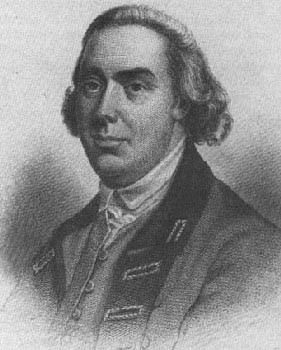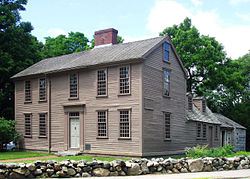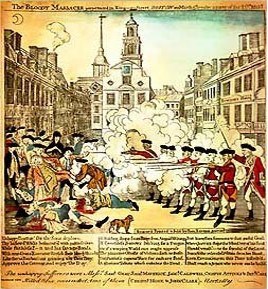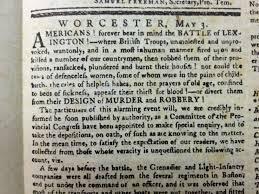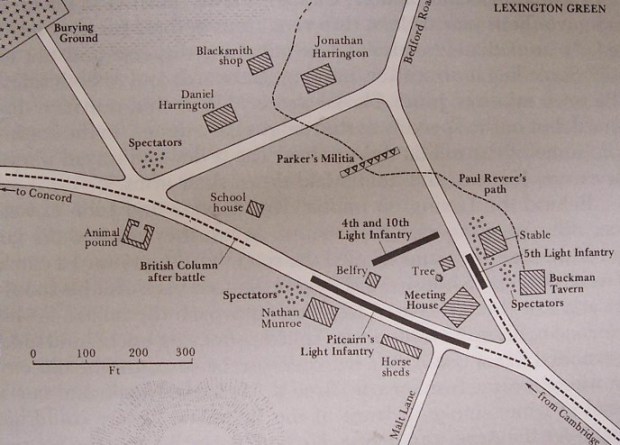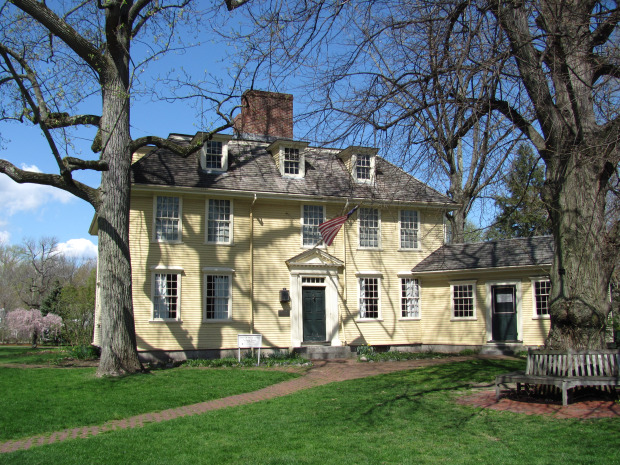The American Revolution, Part I: The Secrets Buried at Lexington Green
By James Perloff | Red Pill Reports
Who Really Fired “The Shot Heard Round The World”?
FOREWORD: I do not expect this two-part article to be very popular among American patriots, many of whom are my dear friends. They are among the core of America’s best citizens; men and women who fight to protect constitutional liberties from the police state, and to preserve U.S. national sovereignty from the tyranny of world government.
The following article raises questions about the American Revolution, which many patriots regard as the foundation of their beliefs. It can be dangerous to shake a good man’s foundation – even if the foundation is flawed – because it might cause him to question his worldview, and weaken his resolve. However, no historical event should be held so sacred as to be immune to examination. Our country is in too much trouble to make truth secondary.
Many patriots say the solution to our problems is to return to the “principles of the Founding Fathers.” I strongly agree with this view in part; I certainly believe in limited government and the Bill of Rights, and that these fundamental doctrines have been eroded to the point of national peril. However, I also believe that much of the trouble actually traces to America’s founding. Despite ubiquitous descriptions of the Founding Fathers as Christians, revolutions are – with rare exceptions – contrary to Biblical doctrine. In Part II, we will explore this issue, and the revolution itself in depth. Right now, we focus on the flashpoint that ignited the war between Britain and her American colonies.
I grew up mostly in Lexington, Mass., where the famed “shot heard round the world” was fired. On my way home from high school each day, I would pass Lexington Green, where colonial militia had assembled on the morning of April 19, 1775, and encountered a force of British redcoats who were on their way to neighboring Concord to confiscate armaments. Shots rang out; eight militiamen died; nine were wounded; the Revolutionary War had begun. The redcoats suffered only one minor wound and continued to Concord, where they found fewer munitions than expected. They spent the rest of the day being routed by superior numbers of militia, on a long and bloody retreat back to their garrison in the city of Boston.
As I walked home, I would pass still-standing Buckman’s Tavern, where the militia had assembled before the battle; and continuing my trek up Hancock Street, would pass the Hancock-Clarke House, another historic site. It was here that Samuel Adams and John Hancock – leaders of the revolution in Massachusetts – had been staying the night before the battle. Paul Revere stopped there to see them on his famous “Midnight Ride.”
These historic matters were hardly on my mind at the time. However many years later, having written widely on political affairs, I took my son on a tour of historic Lexington at his request, and questions began troubling me.
Who fired the first shot has been controversial for over two centuries. Was it the British or Americans? Each side accused the other.
A patriotic friend of mine, who publicly lectures on the battle in a tricorn hat, told me, “Jim, the Americans would never have fired first. You’ve got 80 militia facing 700 British regulars. It would have been suicidal.”
“I see your point,” I said, “but it also seems to me that British troops, under tight discipline, would not have fired without provocation. It’s not like they were on a mission to start battles that day.”
So who did fire the “shot heard round the world”? The answer is important, because that shot ignited the American Revolution, which in turned engendered the world’s most powerful nation. I believe the answer was a dark secret, buried with the dead that April morning.
The Amazing Changing Lexington Portrayals
I direct the reader to the battle’s first artistic depiction, the engraving rendered by Amos Doolittle in the fall of 1775, just a few months after the event.
Note that all the militiamen are retreating or casualties. Not one colonist is firing his gun or even loading.
Next we have the lithograph produced by William S. Pendleton in about 1830:
While a number of militiamen are retreating, some are now shooting.
Next comes Hammatt Billings’s rendering of 1868:
Here very few men retreat; most are engaged.
And finally we have “The Dawn of Liberty,” painted by Henry Sandham in 1886:
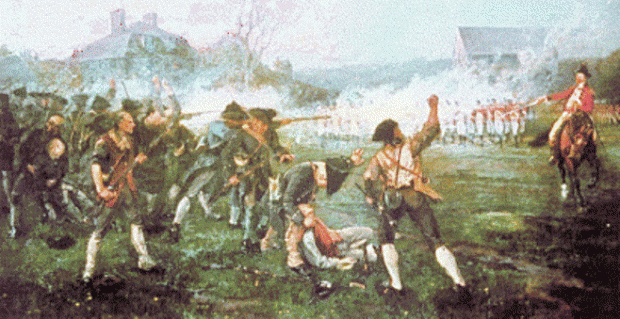
Every man is now standing his ground.
Note the transition from Picture 1 to Picture 4 – from 100 percent retreat to 100 percent defiance. The credit for discovering this revealing sequence goes not to me, but to historian Harold Murdock, who expounded on it nearly a century ago. While the casual observer might dismiss these changes as artistic license or patriotic pride, the truth about Lexington’s “Picture of Dorian Gray” runs much deeper.
Doolittle’s 1775 picture very accurately represented how Massachusetts rebels wanted the event portrayed at that time. Here is how the newspaper Massachusetts Spy reported it in an article widely reprinted throughout the colonies:
Americans! forever bear in mind the BATTLE of LEXINGTON! where British Troops, unmolested and unprovoked wantonly, and in a most inhuman manner fired upon and killed a number of our countrymen . . . It is noticed they fired upon our people as they were dispersing, agreeable to their command, and that we did not even return the fire. Eight of our men were killed and nine wounded; The troops then laughed, and damned the Yankees.
As you can see, the article denied that the militia fired any shots. This accords with the official report authorized by the Massachusetts Provincial Congress, A Narrative, of the Excursion and Ravages of the King’s Troops. It contained the depositions of many Lexington militiamen. All stated the king’s troops began firing on them. Not one deponent expressly admitted to firing a shot, even in retaliation, though they did not deny firing retaliatory shots.
It also agrees with the account by William Heath, the brigadier general who took overall command of the militias as they pursued the redcoats back to Boston. In his postwar memoirs, Heath described the British shooting at the Lexington militia, but made no mention of return fire.1
So, what changed perception of the event? In 1824, as the revolution’s 50th anniversary was approaching, politician Samuel Hoar was giving a public address in Concord. The aging Marquis de Lafayette (who had been a general in the Revolution) was there; Hoar told him he was standing where “the first forcible resistance” to the British occurred. Concord residents affirmed that their town should be credited with firing, as Ralph Waldo Emerson would later phrase it, “the shot heard round the world.” After all, nothing on the official record indicated the Lexington militia had discharged even one round.
This prompted outrage in Lexington, whose denizens insisted the honor belonged to them. And to prove their case, they obtained depositions from 10 aged veterans and witnesses of the battle on Lexington Green. In a stunning variance from the original sworn statements, all deponents now vigorously insisted that the militia fired upon the British, though still claiming the redcoats began hostilities.
This inter-town debate raged for years, and was said to be symbolized in our annual Thanksgiving Day football game, played between Lexington and Concord high schools. Virtually all historians today concede that the Lexington militia fired; the controversy now is over who fired first. The Americans said it was the British; the British said the Americans.
Americans or British?
Though it may offend some U.S. patriots, I agree with Derek W. Beck, American author of the forthcoming book 1775, who concedes that the British reports were more credible. Why?
• The British freely admitted shooting first at the subsequent battle of Concord. Why would they tell the truth about Concord, but lie about Lexington?
• British soldiers said the Americans fired first in their personal diaries, which were not intended for publication. Why would the British lie to themselves in their diaries?
• As we have seen, in 1825 the Lexington militiamen amended the story given in their original 1775 depositions. This shows they were guided by political exigencies of the day, weakening their credibility.
But why would a militia force commence hostilities when outnumbered ten to one? The solution to this mystery requires understanding the historical context.
Freemasonry
Freemasonry deserves mention. In the late 18th century, two bloody anti-royalist revolutions erupted. One, of course, was the French Revolution. Few would deny Freemasonry played a major role in it. This was not only documented by contemporary writers such as Augustin Barruel in Memoirs Illustrating the History of Jacobinsm (1797) and John Robison in Proofs of a Conspiracy (1798), but by Bonnet, orator of the Convent of the Grand Orient Lodge of France, who later declared:
During the 18th century the glorious line of the Encyclopedistes found in our temples a fervent audience, which, alone at that period, invoked the radiant motto, still unknown to the people, of “Liberty, Equality, Fraternity.” The revolutionary seed germinated rapidly in that select company. Our illustrious brother masons d’Alembert, Diderot, Helvetius, d’Holbach, Voltaire and Condorcet, completed the evolution of people’s minds and prepared the way for a new age. And when the Bastille fell, freemasonry had the supreme honor to present to humanity the charter which it had friendly elaborated. . . . On August 25, 1789, the Constituent Assembly, of which more than 300 members were masons, finally adopted, almost word for word, such as it had been for long elaborated in the lodges, the text of the immortal declaration of the Rights of Man. At that decisive hour for civilization, French masonry was the universal conscience . . . .2
Of course, many have noted a distinction between Grand Orient Masonry, practiced on the European continent, and Scottish Rite Masonry, practiced in Great Britain and North America, which they consider more benign. Nonetheless, it is difficult to deny Freemasonic components to the American Revolution.
Paul Revere was dispatched on his famous ride from Boston by Joseph Warren. Warren also sent a second rider, William Dawes, whom history has never glamorized like Revere. Revere and Dawes took different routes and both arrived at the Lexington house where John Hancock was staying. What history books usually omit is that Joseph Warren was Grand Master of St. Andrew’s Lodge in Boston; and that Revere, Dawes and Hancock were all members of that same Lodge. Thus the entire circuit of Revere’s ride, from beginning to end, consisted of Freemasons bound to oaths of secrecy. So we could reasonably ask if there was something to the ride beyond what history reports.
After the war, Revere became Grand Master of the Grand Lodge of Massachusetts, which probably did not impair his subsequent rise to historic glory.
Above: Boston’s Green Dragon Tavern, headquarters of both the Sons of Liberty and St. Andrew’s Lodge
Many other Freemasons were involved in the Revolution. Benjamin Franklin served not only as Grand Master of Pennsylvania, but Grand Master of the Nine Sisters Lodge in Paris, as well belonging to Britain’s satanic Hellfire Club.
Nearly half the generals in the Continental Army were Freemasons – most famously, of course, George Washington, who was later sworn in as President by Robert Livingston, Grand Master of New York’s Grand Lodge.
If you visit Lexington today, at the National Heritage Museum you will see a statue of George Washington donning his Masonic apron. Not surprising, since the museum is run by the Freemasons (its legal name is Scottish Rite Masonic Museum & Library, Inc.). In fact, the entire Northern Masonic Jurisdiction of the United States has its headquarters in Lexington. I do not believe this location was selected by chance.
None of this imputes anything sinister to the vast majority of Freemasons in America today. But it is difficult to dismiss, as coincidental, the influence of Freemasonry on these two revolutions that exploded just a few years apart on separate continents.
Brewers of Revolution
But by far the most important insights into Lexington’s secrets derive from examining the two men who Paul Revere rode to meet there – Samuel Adams and John Hancock.
When most Americans hear “Founding Fathers,” they typically think of Washington, Jefferson, Franklin, Madison and Hamilton. John Hancock is usually remembered only for his extra-large signature on the Declaration of Independence. If an Adams is recalled, it is John Adams, second President of the United States, rather than his second cousin Sam, whom most Americans today identify only as a figure on beer labels.
But Americans of the colonial era would be surprised to learn that Sam Adams has faded into semi-oblivion. Thomas Jefferson said “he was truly the Man of the Revolution.” When he died, the Boston press called him “Father of the American Revolution.” Indeed, the revolution was in many respects a “Massachusetts event” – here was the Boston Massacre, the Boston Tea Party, and the battle that started the war. Sam Adams was entangled in them all.
During the French and Indian War (1754-1763), colonists and British troops had fought on the same side. Samuel Adams, who biographer John Miller called “pioneer in propaganda,” was instrumental in abruptly changing Americans’ perception of British soldiers from “good guys” to “bad guys.”
Britain’s national debt had nearly doubled by the long war’s end, and Parliament felt the burden of paying it off should not be borne by British taxpayers alone, but by the colonists as well, especially since they were the main beneficiaries of the war’s victorious outcome. The result was the Sugar Act of 1764, which placed a tax on molasses of three pennies per gallon.
Sam Adams, a member of the Massachusetts state legislature, was the most outspoken opponent of the Act. Widely quoted in newspapers and pamphlets, he declared:
For if our Trade may be taxed, why not our Lands? Why not the Produce of our Lands & everything we possess or make use of?. . . If Taxes are laid upon us in any shape without our having a legal Representation where they are laid, are we not reduced from the Character of free Subjects to the miserable State of tributary Slaves?3
This established two patterns to Adams’s rhetoric: (1) amplify a perceived wrong far beyond its actual boundaries – i.e., if you gave the king a penny today, tomorrow he would demand a pound; (2) equate British taxation policies with images of slavery.
The Sugar Act was repealed, but it was Britain’s next revenue measures – the Stamp Act of 1765 (repealed in 1766) and the Townshend Acts of 1767 – that catapulted Adams to power. (The Stamp Act would have placed tax on many documents, such as contracts, licenses, diplomas and newspapers, each to require a revenue stamp; the Townshend Acts placed duties on various imports from Britain.) These measures were protested throughout the colonies, but nowhere more violently than Boston. As historian William H. Hallahan notes:
Samuel Adams was gathering and organizing a collection of waterfront mobs who were controlled by his lieutenant, Will Molineaux, a draper; and on occasion even by Paul Revere. Henceforth, Boston was controlled by a “trained mob” glorified by its title: the Sons of Liberty. Sam Adams was its keeper. Adams fashioned another powerful revolutionary tool when he helped spread Sons of Liberty organizations elsewhere in the colonies, where they could be orchestrated into mobs for demonstrations, intimidation, and street violence coordinated with events in Boston.4
Adams became Boston’s political boss, running the city in an early Tammany style. Even before town meetings took place, Adams and his cronies would pre-select candidates at Adams’s private smoke-filled “Boston Caucus” room; votes were often bought at the price of a few tavern drinks, and his thugs ensured control of town meetings at Boston’s Faneuil Hall.
During this rise, Adams recruited the most important ally of his political life: John Hancock.
Both men came from prosperous families. But while Sam Adams turned all his father’s businesses – including a malt house for brewers – into ruins, Hancock became the wealthiest man in Massachusetts, primarily through smuggling operations. A peerless fop, Hancock rode about in a gilded carriage he had specially built in England. Before the revolution began, he even had tailors make him a collection of ornate military costumes he imagined he would wear as commander-in-chief of the Continental Army. When this distinction instead went to George Washington, he bore a grudge that festered for years. Although his extra-large signature on the Declaration of Independence has been popularly ascribed to courageous defiance, it might also be seen as characteristic of his overbearing vanity.
Adams recruited Hancock to be financial angel of the revolution in Massachusetts. Playing to his ego, he allowed Hancock to take the most publicly prominent positions, but there was no doubt that Adams, the back-room intriguer, was the revolutionary mastermind. He soon brought political enemies to heel.
Andrew Oliver, who had been designated distributor of stamps in Boston, was hung in effigy by a mob, had his office vandalized and his home stoned. Adams then forced him to publicly resign before a mob on Boston Common.
Adams learned that terror tactics could be employed to intimidate elected officials as well – by filling the legislature’s gallery with hundreds of his “Mohawks” (Sons of Liberty) and posting the names of legislators considered Tories (British loyalists) on Boston Common’s “Liberty Tree.”
John Mein, who began Boston’s first circulating library, ran an opposition newspaper called the Boston Chronicle. While Adams was forcing Boston merchants to boycott British goods – at great loss to themselves – Mein published ships’ manifests proving that certain traders, including John Hancock, were secretly continuing profitable trade with Britain. A mob then ransacked Mein’s office, and he was attacked on the street by twenty thugs armed with clubs and spades. Orders were handed down for Mein’s arrest, and Sam Adams personally assisted in searching for him. Mein successfully escaped the city, but freedom of the press departed with him.
Home after home of “Tories” were set upon by Adams’s mobs at night. Before undertaking their tasks, they would first get “liquored up“ in Boston’s taverns (making it not inappropriate that Sam Adams is now immortalized on beer bottles). Summoned by bells, whistles, and a horn, the mobs would pour out of the taverns, and descend on the houses of their designated victims, first giving Mohawk “war whoops,” then terrorizing the families and ransacking their homes.
Looting became a “patriotic” act. Destroying the ledger books of creditors was not overlooked. Many loyalists were stripped naked and made victims of the gruesome act of tarring and feathering.
But Adams went too far when he singled out Lieutenant Governor Thomas Hutchinson. Adams roused passions by falsely proclaiming the Stamp Act had been Hutchinson’s brainchild. This was a glaring slander – the Massachusetts-born Hutchinson had opposed the Stamp Act. This mattered little to the drunken mob of some 500 that descended on the lieutenant governor’s house on the night of August 26, 1765. Hutchinson and his family barely escaped with their lives. The mob set upon the house for the entire night, breaking the windows, destroying the walls and furniture with axes, stealing all clothing, silverware and money, obliterating Hutchinson’s library (which contained priceless books and manuscripts) and even pulling down the house’s cupola.
The specter of Hutchinson’s destroyed home sparked an outcry in Massachusetts – Deacon Timothy Pickering, Sr. of Salem later compared the mob to the one that surrounded Lot’s house in the Bible. Throughout the colonies, shame fell on Boston. As a result, Adams was forced to publicly criticize the incident, but he blamed it on “vagabond strangers.”
Eight of the perpetrators were arrested in Boston, but another mob simply broke into the jail and freed them. They were never brought to trial.
Hutchinson minced no words about Sam Adams: “I doubt whether there is a greater Incendiary in the King’s dominions or a man of greater malignity of heart, or who less scruples any measure ever so criminal to accomplish his purposes; and I think I do him no injustice when I suppose he wishes the destruction of every Friend to Government in America.”5
In the manner of Orwellian Newspeak, Sam Adams espoused “liberty” while destroying it; he denounced “tyranny” while establishing it. Liberty is meaningless when granted only to people agreeing with those in power. Edward Bacon, the state legislator from Barnstable, Mass. – where an elderly widow named Abigail Freeman was tarred and feathered by a gang of young thugs for expressing “Tory” opinions – said he preferred the master 3,000 miles away to the one in Boston.6
By 1768, under Adams’s tutelage, Boston had become a bedlam of mob rule and violence. Freedom of speech, freedom of the press, and justice were perishing. At this juncture, British troops were sent to Boston to restore order. One Captain Evelyn would later write to his father, a clergyman in England: “Our arrival has in a great degree restored that liberty they [loyalists] have been so long deprived of, even liberty of speech and security to their persons and property, which has for years past been at the mercy of a most villainous mob.”7
Adams immediately sought to expel these troops. He began circulating to other colonies a “Journal of Events” which alleged that British soldiers were regularly beating small boys and raping the city’s virtuous maidens. Adams did not publish the “Journal” in Massachusetts, where its contents were known to be untrue; but other parts of the continent were easy prey for his atrocity tales. Francis Bernard, governor of Massachusetts, said of Adams’s journal that, even “if the Devil himself” had taken a hand, “there would not have been got together a greater collection of impudent virulent & Seditious Lies, Perversions of Truth & Misrepresentations than are to be found in this Publication.”8 In their own defense, the British soldiers said it would hardly be necessary to resort to rape in a city already so teeming with women of easy virtue.
Adams’s Sons of Liberty began picking fights with redcoats in Boston taverns. One of the trademark quotes of Sam Adams’s career was: “Put your enemy in the wrong, and keep him so, is a wise maxim in politics, as well as in war.” With this principle in mind, Adams sought to generate a catalytic incident – one that would be prelude to Lexington Green.
The Boston “Massacre”
On March 5, 1770, citizens of Boston found handbills posted around the city which read:
this is to inform ye Rebellious People in Boston, that ye Soldiers in ye 14th and 29th Regiments are determend to Joine together and Defend themselves against all who Shall opose them
Signed ye soldiers of ye 14th and 29th Regiments
If, in fact, the redcoats had planned violence against Boston’s citizens, it seems odd that they would broadcast their intentions in advance. Nonetheless, the handbill was used to stir passions among Bostonians.
That evening, summoned by bells, a huge mob, many armed with clubs and staves, descended on King Street. They surrounded the lone sentry on duty near the customs house, taunting him and pelting him with chunks of ice. The sentry called for help. Captain Thomas Preston, officer of the watch at the nearby barracks, came to the sentry’s rescue with seven soldiers. As the bells continued tolling, the crowd grew to some three or four hundred. They closed in on the nine soldiers, hurling rocks, ice and snowballs, and daring them with chants of “Fire!” for they knew the redcoats had orders not to shoot at citizens. As the crowd surrounded the soldiers, they began striking them, and hitting the muzzles of their guns, with cudgels. One soldier, knocked to the ground by a blow from a club, and hearing the word “Fire!” amid the chaos, jumped to his feet and shot at his assailants. Other soldiers fired as well. When it was over, three of the mob lay dead; two were mortally wounded.
The next morning, Sam Adams delivered a fiery speech, and appointed himself and John Hancock heads of a committee that demanded immediate removal of all British troops from Boston. Propaganda went full tilt. Adams’s lieutenant Paul Revere swiftly produced a widely reproduced print of the “massacre” (five deaths being a somewhat hyperbolic use of that term).
It has been noted that Revere’s print included numerous misrepresentations, the most distinct its depiction of the shooting as an orderly volley, given on an officer’s command, suggesting it was a premeditated expression of official British policy. Adams’s committee, which also included Joseph Warren – Grand Master of Boston’s Freemasons – and mob leader William Molineux, ordered publication of A Short Narrative of the Horrid Massacre in Boston. It contained dozens of collected depositions, depicting the incident as unprovoked wanton murder. Reading them, one is impressed that there was hardly a citizen of Boston who was not molested by Captain Preston and his men that night. The depositions read as though written by a seedy playwright of maudlin melodramas. Perhaps Adams had discovered that depositions, like votes and rioters, could be bought with a few tavern drinks (and possibly with Masonic countersigns, for anyone who considered an oath to the brotherhood to outweigh an oath to tell the truth).
Two samples:
Deposition number 31:
I, Nathaniel Appleton, of lawful age, testify, that on Monday evening the 5th instant . . . I went to my front door and saw several persons passing up and down the street, I asked what was the matter? was informed that the soldiers at Murray’s barrack were quarrelling with the inhabitants. Standing there a few minutes, I saw a number of soldiers, about 12 or 15, as near as I could judge, come down from the southward, running towards the said barrack with drawn cutlasses, and appeared to be passing by, but on seeing me in company with Deacon Marsh at my door, they turned out of their course and rushed upon us with uplifted weapons, without our speaking or doing the least thing to provoke them, with the utmost difficulty we escaped a stroke by retreating and closing the door upon them. I further declare, that at that time my son, a lad about 12 years old, was abroad on an errand, and soon came home and told me that he was met by a number of soldiers with cutlasses in their hands, one of which attempting to strike him, the child begg’d for his life, saying, pray soldier save my life, on which the soldier reply’d, No damn you, I will kill you all, and smote him with his cutlass, which glanced down along his arm and knocked him to the ground where they left him, after the soldiers had all passed, the child arose and came home, having happily received no other damage than a bruise on the arm.
Deposition No. 66:
I, John Wilson of lawful age testify, that on monday evening the 5th current, I . . . heard the bells ring and . . . I asked what was the matter? The people said the soldiers had insulted the inhabitants . . . . Then I came down King street opposite the custom-house, and saw a man with a light color’d surtout coming from the main guard go up to the centry, and lay his hand on his shoulder and speak some words to the centry, and then enter the custom-house door. On this the centry grounded the breech of his gun, took out a cartridge, primed and loaded, and shoulder’d his firelock. After this I drew back opposite Mr. Stone’s, & in a few minutes saw a party of soldiers headed by an officer coming down from the main guard, crying to the inhabitants, Damn you, make way you boogers! I not moving from my place was struck by one of them on the hip with the butt of his musquet, which bruised me so much that it was next day very sore, and much discoloured. The officer seeing the soldier strike me said to the soldier in an angry manner why don’t you prick the boogers? The party drew up before the custom-house door, and ranged to the west corner in a half circle, and charged their pieces breast high. Some small boys coming up made a noise to the soldiers, on which the officer said to them why don’t you fire? Damn you, fire! They hereupon fired, and two men fell dead in my sight.9
These depositions portrayed the soldiers “Adams style” – cowards who beat children, who shot without provocation, their conduct motivated by officers. (Note the claims of having received bruises, which fade away and, unlike wounds, leave no scar that could corroborate injury.)
The soldiers were tried for murder, and Sam Adams expected that, with a jury stacked with his “Mohawks,” he would soon see redcoats swinging from gallows on Boston Common. But the defense was led by Sam’s second cousin John – the future President – who, despite threats against himself, did a creditable job. He saw to it that the jurors came from outside Boston, and 38 witnesses testified that there had been a plot that night to attack the redcoats. The prosecution did not even enter into evidence the threatening handbill alleged to have been written by the soldiers.
The most crushing blow for Sam Adams came with the deathbed confession of one of the two mortally wounded men – Patrick Carr. Carr said the soldiers had been provoked into shooting; that they had shown far greater restraint than the British soldiers Carr had seen facing mobs in his native Ireland; and he forgave the soldier who shot him, as he had pulled the trigger in self-defense.
Outraged, Sam Adams publicly denounced Carr’s confession. Playing to the prejudices of the day, he said it should be disregarded because Carr was a “Papist.”10
The jury acquitted all but two of the soldiers, who were convicted of manslaughter. No redcoats swung from the gallows. Sam’s cousin John – tactfully without naming names – remarked of the incident: “I suspected that this was the explosion which had been intentionally wrought up by designing men who knew what they were aiming at, better than the instruments employed.”11
The verdict stung Sam Adams, but taught him lessons that would prove useful. And he continued to play the massacre for all it was worth. As the master of melodramatic propaganda, it is believed he had a great hand in writing John Hancock’s torrid Boston Massacre fourth-anniversary oration, of which here is a small sampling. Bear in mind these words were being spoken more than three years after a Massachusetts jury rejected the murder charges brought against the troops:
But I forbear, and come reluctantly to the transactions of that dismal night . . . when Satan, with his chosen band, opened the sluices of New England’s blood, and sacrilegiously polluted our land with the dead bodies of her guiltless sons! Let this sad tale of death never be told without a tear . . . let every parent tell the shameful story to his listening children until tears of pity glisten in their eyes, and boiling passions shake their tender frames . . . let all America join in one common prayer to heaven that the inhuman, unprovoked murders of the fifth of March, 1770 . . . executed by the cruel hand of Preston and his sanguinary coadjutors, may ever stand in history without a parallel. . . . And though the murderers may escape the just resentment of an enraged people; though drowsy justice . . . still nods upon her rotten seat . . . . Ye dark designing knaves, ye murderers, parricides! how dare you tread upon the earth which has drunk in the blood of slaughtered innocents, shed by your wicked hands?
The Boston Tea Party
As it did with the Sugar Act, England had repealed the Stamp Act (from which it never collected one penny) in response to colonial protests.
In 1766, a frustrated Parliament, still seeking a practical means of raising revenues from the colonies, summoned Benjamin Franklin, the leading representative of American interests in Britain. The following exchange is of interest:
Q. What was the temper of America toward Great Britain before the year 1763?
A. The best in the world. They submitted willingly to the government of the Crown, and paid, in their courts, obedience to acts of Parliament. . . .Q. Did you ever hear the authority of Parliament to make laws for America questioned till lately?
A. The authority of Parliament was allowed to be valid in all laws, except such as should lay internal taxes. It was never disputed in laying duties to regulate commerce. . . .Q. Was it an opinion in America before 1763 that the Parliament had no right to lay taxes and duties there?
A. I never heard an objection to the right of laying duties to regulate commerce; but a right to lay internal taxes was never supposed to be in Parliament, as we are not represented there. . . .Q. On what do you found your opinion that the people in America made any such distinction?
A. I know that whenever the subject has occurred in conversation where I have been present, it has appeared to be the opinion of every one that we could not be taxed by a Parliament wherein we were not represented. But the payment of duties laid by an act of Parliament as regulations of commerce was never disputed.12
Based on assurances, such as these from Franklin, that the colonies would respect Britain’s right to place duties on her own commerce, Parliament passed the Townshend Acts, assigning duties on various British goods sold in America. Sam Adams then coerced Boston merchants to sign his “nonimportation agreement” on pain of being otherwise named a public enemy and subject to mob violence (this had been prior to the arrival of the British troops). As we have seen, while Boston merchants were going broke from the boycott, Adams looked the other way as his friend John Hancock continued profitable trade with Britain – to borrow Orwell’s phrase, all animals are equal, but some animals are more equal than others.
In response to colonial protests, Parliament caved in – again. They removed duties on all goods except one: tea, via the Tea Act of 1773. The tea duty was nominal – three pennies on a pound. (It would be interesting to measure this against the 6.25% sales tax Massachusetts currently levies on its citizens.) Furthermore, the tea, which was surplus tea of the East India Company, was offered to colonists at half the price Englishmen paid for it.
In fact, the tea was so cheap that it was underselling the Dutch tea John Hancock’s ships were smuggling in. In the Boston Tea Party of December 1773, of course, the Sons of Liberty, after being customarily liquored up, hurled hundreds of chests of English tea into Boston Harbor. From Hancock’s perspective, this was largely cutthroat business tactics: to maximize your profits, destroy your competitor’s merchandise. Although I have friends in today’s “Tea Party” movement, I regret that its name is fashioned after an act of vandalism. This is our inheritance from Sam Adams, who, by semantics, transformed criminal deeds into patriotic ones.
While Hancock had an ulterior motive of profit in the Boston Tea Party, Adams’s motive was to push the nation toward revolution. The dependable Paul Revere was dispatched to New York and Philadelphia with the news. Moreover, the incident was bound to push England into reacting, as had been the strategy of the Boston Massacre – to, as Adams liked to phrase it, “Put your enemy in the wrong.”
The “Tea Party” sparked outrage in Britain. Parliament, feeling that they had tolerated enough from Boston, ordered the port closed until the damage was paid for. General Thomas Gage was sent as military governor.
This played right into Sam Adams’s hands. Many in Massachusetts wanted the East India Company compensated, but Adams blocked every move to pay for the tea.13 The prolonged port closure brought Boston commerce to a standstill, inciting sympathy for the city in the other colonies.
A reading of British newspapers and speeches in Parliament reveals that Britain considered Boston the source of more trouble than all the other colonies combined. But characteristically, Adams projected the measures, aimed solely at Boston, as aimed at all colonies. In a letter to the Philadelphia Committee of Correspondence, he wrote:
This attack, though made immediately upon us, is doubtless designed for every other colony, who will not surrender their sacred Rights & Liberties into the Hands of an infamous Ministry. Now therefore is the Time, when ALL should be united in opposition to this Violation of the Liberties of ALL.14
First Continental Congress
As Miller notes, “No American patriot had demanded more vigorously than Sam Adams a Continental Congress to unite colonial opposition to Great Britain.”15 The First Continental Congress met in Philadelphia in 1774, and into this city Sam Adams brought his Boston brand of politics. Quoting Hallahan:
Sam Adams’s first step on arriving at Philadelphia was to visit the docks and piers of the riverfront with a local politician, Charles Thomson, who liked to describe himself as the Sam Adams of Philadelphia. Adams spent some time on the docks and in the taverns talking with the workingmen there, pressing the flesh and preaching his incendiary politics. He quickly won many converts – and lined up some muscle.16
Although Joseph Galloway, moderate delegate from Pennsylvania, had proposed the Pennsylvania State House as the venue for the convention, Sam Adams pressed for meeting in the smaller, somewhat cramped quarters of the more populist, recently built Carpenter’s Hall because the workingmen of the city identified with it. . . . Galloway noted that it was no coincidence that workingmen from the docks were loitering on the grounds around Carpenter’s Hall in an intimidating manner.17
Sam Adams ran Carpenter’s Hall much like he did Faneuil Hall, doing back-room politicking before actual votes. Through such machinations, he had himself made temporary secretary of the convention, then Thomson permanent secretary.
Meanwhile back in Boston, by prearrangement, Adams’s lieutenant Joseph Warren hosted a meeting of radicals at Faneuil Hall; they passed a resolution called the “Suffolk Resolves” (Suffolk is Boston’s county). The resolves called for a boycott of all British goods, for all towns to raise militias, and for “the inhabitants of those towns and districts, who are qualified, to use their utmost diligence to acquaint themselves with the art of war as soon as possible, and . . . appear under arms at least once every week.” This was a radical step toward war. Warren then dispatched Paul Revere – as he would on the “Midnight Ride”– to Philadelphia with a copy of the resolves, which the Continental Congress officially endorsed.
Joseph Galloway, leader of the moderates, proposed a plan of reconciliation with Great Britain. Later, a gallows noose was delivered to his door, and the next night a message that read: “Hang yourself or we will do it for you.” Galloway said he lived “in the utmost danger from the mobs raised by Mr. Adams of being hung at my own door.”
Every night I expected would be my last. Men were excited by persons northward [Boston], by falsehoods fabricated for the purpose, to put me to death. Several attempts were made.18
Sam Adams’s climactic maneuver at the Continental Congress was procuring a pledge from the delegates that, should armed conflict erupt between Massachusetts and British troops, the other colonies would come to the aid of Massachusetts. However, the delegates, distrustful of Adams, attached an important condition to this pledge. They would only help Massachusetts if the British fired first. When Sam Adams returned home, he had one paramount goal: to produce just such an incident.
Lexington Coming
However, all during the winter of 1774-75, General Thomas Gage, commander of British forces in Boston, gave Adams no opportunity. As political flames raged, loyalists sought refuge in Boston, while many rebels evacuated the city. Boston became a loyalist stronghold, surrounded by a sea of hostile patriots, and Gage had no desire to venture his troops against the increasingly prepared – and mandatory – minutemen militias.
General Gage
In April 1775, the Second Continental Congress – at which Hancock would preside as president – was due to begin the following month. Sam Adams desperately needed a “British fired first” incident to bring before the Congress. Otherwise, the passion for revolution might wane, the moderates would prevail, and there would be no war.
At this juncture, what Hallahan calls “bait” was offered to lure Gage out. Adams and Hancock had been attending the Massachusetts Provincial Congress (the colony’s provisional independent government) in Concord. General Gage began receiving intelligence reports that large amounts of munitions, including cannons, were stored in Concord for an army the Provincial Congress planned to raise. Some of the reports exaggerated the quantity of munitions. A number of Gage’s reports came from Benjamin Church, the notorious double agent whose true loyalties have long been controversial.
Gage now made the fateful decision to send troops to neutralize the Concord munitions before they could be deployed against his own forces. En route, they would have a “date with destiny” in Lexington.
Can it only be coincidence that, on the night before the battle, Adams, Hancock and Revere – the apparent mastermind and leading propagandists of the “Boston Massacre” – were congregating in a house a few hundred feet behind Lexington Green? (The house, still standing, is called the Hancock-Clarke House.) It was owned by Reverend Jonas Clarke, Lexington’s firebrand patriot-preacher whose wife was Hancock’s cousin.
It has been traditionally reported that Revere rode to the house to warn Adams and Hancock that the British forces might be on a mission to arrest them. However, although England had authorized Gage to apprehend revolutionary leaders, including the famous pair, evidence repudiates that this was Gage’s intention that day:
(1) Gage’s orders to Lieutenant Colonel Smith, who commanded the expedition, only discuss securing the Concord munitions, and make no mention of arrests;
(2) A force of 700 foot soldiers would be an extremely inefficient instrument for performing an arrest;
(3) In Lexington, the British made no movements toward the Hancock-Clarke House;
(4) After his initial meeting with Adams and Hancock, Revere rode on toward Concord, but was captured by an advance British patrol at 1 AM. The British knew they had Adams’s famed lieutenant Paul Revere in their hands – but eventually turned him loose. Had they truly been after Adams and Hancock, they should have held on to Revere, for no one would better know their whereabouts. (After being released, Revere rejoined Adams and Hancock in Lexington.)
If, in fact, Adams and Hancock were worried about arrest by the British, they displayed little alarm, tarrying at the house long after Revere’s warning. Furthermore, examination of a letter written by Hancock reveals they had already received intelligence about the British movements at 9PM on the 18th – three hours before Revere’s arrival. See the New York Times article “Letter Deepens Doubt on Paul Revere’s Ride.”
Revere’s 1775 deposition, describing his midnight ride, makes little mention of alarming the countryside, or shouting that the regulars were coming, as is famously ascribed to him. He very probably did so, and he certainly discussed it in his postwar account many years later, but in the original deposition he emphasizes going straight from Joseph Warren to see Adams and Hancock – this, apparently, was his foremost objective.
In the wee hours of the morning of the 19th, Adams, Hancock and Clarke walked down to Lexington Green and had a discussion with the militia that had gathered at Buckman’s Tavern in response to the town’s alarm bells. Half a century ago, historian Arthur B. Tourtellot wrote:
Adams and Clarke unquestionably made up a policy between themselves. Adams knew the broad strategy of the resistance, because he was at this point its sole architect. Clarke knew the men of Lexington and, what is more, could control them as no outsider could. The policy determined upon between the time of Revere’s first alarm and of the minutemen’s first muster and the time of the actual arrival of the British troops, was for the minutemen, however outnumbered, to make a conspicuous stand but not to fire.19
The conversation between Adams, Hancock, Clarke and the militia at Buckman’s Tavern has never been revealed, but we know that:
• Adams urgently needed a “British fired first” incident to bring to the upcoming Continental Congress.
• Adams had famously said, “Put your enemy in the wrong, and keep him so, is a wise maxim in politics, as well as in war.”
• Adams had evidently orchestrated the “Boston Massacre.”
Boston Massacre/Lexington Massacre
Indeed, the Lexington affair was sometimes styled the “Lexington Massacre,” and uncanny parallels exist between the two events:
• Prints of each were made. Compare Revere’s notorious misrepresentation of the Boston Massacre to Doolittle’s depiction of Lexington:
In each picture, the colonists, who offer no provocation, are being slaughtered by a synchronous, orderly volley from redcoats upon an officer’s command. This in spite of British reports that shooting at both incidents was sporadic and not in response to orders. You might recall the words of John Wilson, a deponent, regarding the Boston Massacre:
“Some small boys coming up made a noise to the soldiers, on which the officer said to them why don’t you fire? Damn you, fire! They hereupon fired.”
Now look at the words of William Draper, a deponent regarding the battle of Lexington:
“The commanding officer of said troops (as I took him) gave the command to the troops, fire, damn you fire, and immediately they fired.”
Two separate incidents five years apart, two different officers. Was it standard practice for British officers to instruct their men to shoot with the words, “Fire, damn you, fire”? One gets the impression that these depositions were scripted by the same writer.
• Indeed, depositions were another common denominator to both events – collected, widely published, and claiming the colonists offered no provocation whatsoever. But as we have also seen, for the Boston Massacre, these claims did not stand up in court. In the case of the “Lexington Massacre,” Adams knew the depositions would not be tested by cross-examination, since war had commenced and there would be no trial. However, the Lexington depositions received their own taint 50 years later, when town pride demanded new depositions amending the first ones. (At that point, Sam Adams was long dead and no one feared his vengeance.)
• Both incidents were followed by intense communications with neighboring communities via dispatch riders. For the latter event, the History of the Town of Lexington notes:
The report of the bloody transaction at Lexington spread as on the wings of wind, and the fact that the regulars had fired upon and killed several citizens was known not only in the neighboring towns, but to the distance of forty or fifty miles in the course of the forenoon. The people immediately flew to arms. . . .20
Other colonies were also rallied to arms by reports of the Lexington “massacre” from dispatch riders traversing the coast.
• Both incidents were the subject of vitriolic, dishonest depictions of the British troops’ behavior. Do you recall Hancock’s florid language in his Boston Massacre oration, and Adams’s claim that soldiers were regularly raping Boston ladies? Now let’s examine more closely the widely distributed report of Lexington, in the newspaper the Massachusetts Spy. Bear in mind that the newspaper’s publisher, Isaiah Thomas, met with Adams and Hancock in Worcester, Massachusetts, before printing this:
Americans! forever bear in mind the BATTLE of LEXINGTON! where British Troops, unmolested and unprovoked wantonly, and in a most inhuman manner fired upon and killed a number of our countrymen, then robbed them of their provisions, ransacked, plundered and burnt their houses! nor could the tears of defenseless women, some of whom were in the pains of childbirth, the cries of helpless babes, nor the prayers of old age, confined to beds of sickness, appease their thirst for blood!—or divert them from the DESIGN of MURDER and ROBBERY! . . . It is noticed they fired upon our people as they were dispersing, agreeable to their command, and that we did not even return the fire. Eight of our men were killed and nine wounded; The troops then laughed, and damned the Yankees.
The report speaks of “defenseless women, some of whom were in the pains of childbirth.” It is true that, during the bloody retreat back to Boston, the British burned a number of houses, especially those from which they were fired on. However, no historian has ever found a case where a woman in childbirth was in any way molested. The closest instance was Hannah Adams, who had an 18-day-old baby, and was forced to evacuate her home. Hannah was not injured, nor the child, who grew up and was herself married.21
As for those in “old age,” again, there is no known case except 79-year-old Samuel Whittemore. When the British were retreating through the town of Menotomy, Whittemore, a feisty old war veteran, fired at them from behind a stone wall with a musket and pistols – killing two redcoats and mortally wounding another. The British troops furiously shot and bayoneted him. Obviously one cannot plead “old age” when bearing arms, and clearly he was not, as the Spy put it, “confined to a bed of sickness.” Whittemore survived and died at 97 of natural causes.22
The Hannah Adams/Whittemore incidents were inflated by the Massachusetts Spy into countless assaults upon the gentler sex and elderly. People reading the broadsides in other colonies had no way of knowing these tales were false. This helped establish a pattern – for the last two centuries, Americans have been provoked to war by fabricated atrocity stories spun in the press. In the Spanish-American War, it was Spaniards throwing Cubans to sharks and roasting Cuban priests; in World War I it was German soldiers bayoneting Belgian babies; in the 1991 Gulf War it was Iraqi soldiers throwing Kuwaiti babies out of incubators. Small wonder that Thomas Jefferson, himself later victimized by newspaper smears, wrote:
Nothing can now be believed which is seen in a newspaper. Truth itself becomes suspicious by being put into that polluted vehicle. The real extent of this state of misinformation is known only to those who are in situations to confront facts within their knowledge with the lies of the day.23
Oddities at Lexington Green
What really did happen in Lexington on April 19, 1775? My patriot lecturer friend had told me the militia would not have fired first, because they were outnumbered ten-to-one. But this begs another question: if hopelessly outnumbered, why stand on the green in the first place?
The Lexington militia behaved very distinctly from other militias that day. When the British reached Concord, the militia there wisely withdrew to the safety of a hill, then waited until strong reinforcements arrived from other towns. And all through the day, as the British retreated to Boston, the militias attacked, but from behind trees, walls, and house windows.
How different was the Lexington militia! They stood on an open green, holding their rifles in formation. Did this not invite confrontation? The redcoats could obviously not march past a hostile armed force on their flank, or leave it threatening their rear.
Adams and Hancock, who conferred with the militia before the incident, were the two most powerful figures in Massachusetts (after the war, Hancock became the state’s governor, with Adams his lieutenant governor). The Lexington militia was under the immediate command of Captain John Parker, an old French and Indian War scout. However, all Massachusetts militias fell under the authority of the Provincial Congress, of which Hancock was president, and the Massachusetts Committee of Safety, of which Hancock was chairman. And since Hancock had already had several uniforms tailored for his self-envisioned role as commander of the entire Continental Army, he would hardly demur at giving orders to a local militia captain.
Although Adams and Hancock fled to neighboring Woburn before the shooting began, Paul Revere himself arrived at the green about a half-hour prior to the redcoats marching in at dawn. This bears comment.
Supposedly, Revere went to the green with Hancock’s clerk John Lowell (yet another Freemason from Boston’s St. Andrew’s Lodge), because Hancock had forgotten that he had stored, at Buckman’s Tavern, a heavy trunk containing important documents he feared the British would discover. This means Revere was mingling with the Lexington militia, who were also at Buckman’s Tavern, until the moment the British arrived – when, he said, he and Lowell then hurried along with the trunk on foot.
While this story may be entirely true, it presents peculiarities:
• Hancock himself had already been to Buckman’s Tavern that morning. If the trunk was so vital, one would think he would have remembered it then.
• It seems an unlikely concern that the British would have diverted from their expedition to search Buckman’s Tavern, which of course they didn’t.
• It seems strange that Hancock did not send his coach for the trunk, which could have spirited it away expeditiously. Surely having Revere and Lowell haul it on foot posed greater danger of its apprehension by the British.
• In case anyone thinks Hancock couldn’t risk sending his gilded coach back to Lexington – he did send it back, famously, to the Hancock-Clarke house, to fetch a salmon he wished for his breakfast. While Hancock was enough of a fop for such a vain stunt on the morning that a war was beginning, it begs the question of why he sent the carriage for the salmon, but not the all-important trunk.
The Shot(s) Heard Round the World
Early in this article, we listed reasons why British accounts of Lexington are more credible than American ones. So let’s reconstruct the event based on their reports. Bear in mind that the British were already under strict orders not to fire unless fired upon.
Lieutenant William Sutherland and Lieutenant Jesse Adair were riding ahead of the marching column. As they approached Lexington village, they heard shots to their left and right, but hearing no balls whistling, assumed it was a local alarm signal. Then they then saw a colonist aim his musket at them and pull the trigger – but it “flashed in the pan”; that is, the primer powder failed to ignite the charge in the musket.
Sutherland and Adair rode back and reported this incident to Major John Pitcairn, commander of the lead column. Pitcairn, who had already heard warnings along the road that a hostile force was waiting at Lexington, now told his troops to load their guns and fix bayonets. He then ordered them to advance, but not to fire under any circumstances without orders.
Here is a map of the disposition of the Lexington battle:
When the British troops spotted the militia on the green, they split left and right to flank them. At this point, the first shots at the green itself were fired. Quoting Lieutenant Sutherland:
We still went on further when 3 shot more were fired at us, which we did not return, & this is sacred truth as I hope for mercy These 3 shots were fired from the corner of a large house to the right of the Church.24
The house Sutherland referred to is Buckman’s Tavern. (The “church” and the “meeting house” on the map are one and the same.) Since there were, of course, no repeating rifles then, this means three shooters. The first of these shots might technically be the “shot heard round the world.” But though the militias were noted for their marksmanship, all three shooters missed their targets.
Ignoring the shots, the British kept focused on the militia on the green. Major Pitcairn rode up toward them, and ordered them to throw down their guns and disperse. At this point, both British and American accounts concur that the militia began dispersing. However, according to the British, four or five of the militia suddenly dove behind a wall and fired:
Major Pictairn: “some of the rebels who had jumped over the wall, fired four or five shots at the soldiers.” Lieutenant Sutherland: “instantly some of the villains who got over a hedge [wall] fired at us which our men for the first time returned.” Ensign Jeremy Lister, writing an account several years later, reversed the sequence and said: “they gave a fire then run off to get behind a wall.” Since Pitcairn’s and Sutherland’s accounts were written shortly after the event, they can be assumed more chronologically accurate. Pitcairn’s report also noted that his horse was hit by shots fired from “some quarter or other” and “at the same time several shots were fired from a Meeting House on our left.”25
(I would like to interject here that Major Pitcairn, who later died at Bunker Hill, was not a man to whitewash a report; he was widely known for his integrity and courage, such that even the Sons of Liberty paid him respect, a high compliment indeed.)
So, not counting the “flash in the pan,” we have three shots from Buckman’s Tavern, four or five shots by the men who jumped behind the wall, perhaps more from “some quarter or other,” and “several” from the meeting house. Based on the British reports, it appears that possibly upwards of ten shots were fired on the redcoats before they returned fire. According to all British accounts, their return fire was not based on orders given, but was a spontaneous, disorderly reaction to the multiple shots the Americans fired. The green now billowed with musket smoke, and the British officers had to restrain their men with considerable difficulty.
The three men who fired from the corner of Buckman’s Tavern surely knew they were jeopardizing the militia on the green. So must have the men who jumped the wall. It is noteworthy that Paul Revere – whose alarm brought the militia out in the first place – had been at Buckman’s Tavern only moments before the “shot heard round the world” was fired from that very place. The map details Revere’s path, which took him from Buckman’s right through the militia. Was he really there just to haul a trunk, or was he choreographing the incident, passing instructions as he moved along?
Buckman’s Tavern still stands across from the green.
Of course, I don’t believe for a moment that the Lexington militiamen were planning to sacrifice themselves as cannon fodder, any more than the mob at the “Boston Massacre.” I suggest that only a few were “in the know” – the individuals who fired the opening rounds from protected places, leaving the men on the green to absorb the fury of British retaliation.
But is there any evidence that there was a group separate from the Lexington militia? There is. Later in the day, as the redcoats were retreating from Concord, General Gage sent a relief column from Boston under Brigadier Hugh Percy. Riding as a scout for Percy’s column was an American loyalist, George Leonard. His statement is among General Gage’s papers:
George Leonard of Boston deposes that he went from Boston on the nineteenth of April with the Brigade commanded by Lord Percy upon their march to Lexington. That being on horseback and having no connexion with the army, he several times went forward of the Brigade, in one of which excursions he met with a countryman [fellow American] who was wounded supported by two others who were armed. This was about a mile on this side of Lexington Meeting House. The deponent asked the wounded person what was the matter with him. He answered that the Regulars had shot him. The Deponent then asked what provoked them to do it – he said that some of our people fired upon the Regulars, and they fell on us like bull dogs and killed eight and wounded nineteen. He further said that it was not the Company he belonged to that fired but some of our Country people that were on the other side of the road. The Deponent enquired of the other men if they were present. They answered, yes, and related the affair much as the wounded man had done. All three blamed the rashness of their own people for firing first and said they supposed now the Regulars would kill everybody they met with.
Boston, May 4, 1775
George Leonard 26
Note Leonard’s report that the wounded man said “it was not the Company he belonged to that fired but some of our Country people that were on the other side of the road.” This indicated the Buckman Tavern area, across the street from the green. It shows that Lexington’s armed men were not one cohesive unit.
The phrase “not the Company he belonged to” adds interest to the wording of the Lexington militia’s depositions. 34 deponents signed a statement declaring that “not a gun was fired by any person in our company on the regulars to our knowledge before they fired on us.” Another 14 signed a statement that “the regulars fired on the company before a gun was fired by any of our company on them.” (Emphasis added.) These statements don’t exclude the first shots being fired by Americans – rather, they deny any such shots came from “our company.” This nuance may have been important in persuading some militiamen to sign the collective depositions. If anyone’s conscience gave him pause, men like Reverend Clarke could always assure him that the statement was, technically, true; and that one’s patriotic duty to avenge the dead outweighed considerations over exactness.
Who were these gunmen who fired the opening shots from protected places? It seems highly doubtful that they were members of the Lexington militia, who would not have willfully endangered their friends and kinsmen. Of course, some shots came from the four or five men who, having been on the green, jumped a wall and fired; but not every man that had assembled on the green was from Lexington; some told Parker they had come from neighboring districts, having heard the town’s bells tolling. William Draper (who signed the deposition saying the British officer cried “Fire, damn you, fire!”) gave his residence as the faraway town of Colrain. Is it possible that John Lowell was not the only Freemason from St. Andrew’s Lodge whom Revere brought to the green shortly before the British arrived? A number of Sam Adams’s “Mohawks” had fled Boston after its loyalist consolidation and would have been at large that April. Was the “Boston Massacre” strategy being replayed?
Though I will doubtlessly be accused of gross speculation, I would like to know a better reason why, with the militia hopelessly outnumbered, a few men fired on the redcoats from concealed locations, leaving the militia on the green to bear the consequences. And I would also like to hear why the town of Lexington kept its firing – of shots of any kind – essentially a secret for fifty years.
I now offer further speculation. You will recall that when lieutenants Sutherland and Adair, riding in advance, approached the green, they saw a colonist aim his musket and pull the trigger, but the powder “flashed in the pan.” The officers thought they had been spared by a lucky “misfire.”
Then we have three shots from Buckman’s Tavern that all missed. And with the shots from the wall and the meeting house, and any in the subsequent exchange, the British suffered only one wound; none were killed. This is quite a contrast to the rest of the day, when the redcoats suffered some 250 casualties. Remember, even 79-year old Samuel Whittemore killed three redcoats firing from behind a wall. Yet the Lexington men, with a multitude of shots from various locations, couldn’t inflict one significant hit on the troops amassed before them.
Perhaps there were no British dead at Lexington Green because Adams and Hancock wanted none. If redcoats had to be buried in the village, it might have cast doubt on the tale of an “unprovoked massacre.” I suggest that some shooters may have missed on purpose, perhaps even firing “without ball.” Perhaps the “flash in the pan” was not a misfire but an attempt to provoke without drawing blood.
What the British marched into was a trap. No matter the precise details, the outcome was virtually guaranteed:
• The militia standing in battle formation guaranteed the redcoats would confront it.
• Firing shot after shot at the British guaranteed that at some point a threshold would be reached, and the redcoats would fire reciprocally – very parallel to the “Boston Massacre,” where soldiers were pelted and clubbed to the point of shooting in self-defense.
• Firing but deliberately missing guaranteed the British would experience few if any casualties; there would be high colonist casualties by comparison. Thus statistics would corroborate the “Lexington massacre” story.
Perhaps John Adams’s comment on the Boston Massacre bears repeating here: “I suspected that this was the explosion which had been intentionally wrought up by designing men who knew what they were aiming at, better than the instruments employed.”
For John Hancock, the battle of Lexington, like the Boston Tea Party, was profitable; with the outbreak of war, some 500 smuggling indictments, pending against him in the courts, vanished.27 But for Sam Adams, the picture was much broader. Upon hearing the distant Lexington gunfire, he turned to Hancock and famously said, “What a glorious morning is this!” As historian William Hallahan put it, “For the price of a few dead farmers, Adams could buy his war.”28
Afterword
Obviously, Samuel Adams is “the villain of my piece.” Am I obsessed with hating him? Have I nothing good to say of the man?
To Adams’s credit, he was not, like Hancock, a materialist. He lived a simple, frugal lifestyle, and did not seek riches from his revolutionary agitations.
In fact, it has been said that he sought to emulate his Puritan forefathers. He prayed, read the Bible, and, after the war, even publicly opposed amusements such as clubs for card-playing. However, to oppose card-playing, while suborning mob violence and property destruction, and habitually engaging in “ends justify the means” lying and slander, is to mis-prioritize virtues, a practice that Jesus Christ condemned the Pharisees for.
To his credit, Adams opposed centralization of government under the Constitution unless amendments (i.e., the Bill of Rights) were appended. Yet many found Adams’s postwar views on liberty self-contradictory. For example, when rural Massachusetts farmers and veterans, finding their property confiscated for inability to pay state taxes and debts, began what was known as “Shay’s Rebellion,” Sam Adams (then president of the Massachusetts senate) called the rebels “traitors,” declared that their leaders should be executed (two were hung), and helped push through a senate bill suspending the right of habeas corpus during the crisis.
But my article raises a far more significant matter. It has concluded that the Massachusetts events, used to spark the Revolutionary War, were predominantly specious. What, then, does that say about the war itself, the American nation it spawned, and the Founding Fathers in general? I will address these issues in Part II. However, since that will take time to write (I am still researching Part II and will probably post other articles before its completion), I am going to cast water at some fires I have already lit.
Some may accuse me of being an “anglophile” for writing the preceding article. But – other than enjoying old comedies with Peter Sellers and Alec Guinness – I plead innocent. I have never visited the UK, and no British blood flows in my veins. I have no motive other than seeking truth.
I am not, repeat not, seeking to bring America back under British dominion. In point of fact, a destructive Anglo-American political alliance, nurtured by banks and multinationals, has been in effect for over a century, and anyone familiar with my other writings knows how bitterly critical I have been of those interests.
As an American, I may also be accused by a few of being unpatriotic, perhaps even treasonably so. I would like to answer that potential charge.
I have lived nearly all my life in and around Boston. As is well known, Bostonians have long had a near-fanatical love of their baseball team, the Red Sox, a passion matched only by their hatred for the team’s nemesis, the New York Yankees.
At a sporting event, it is OK, if one wants, to imagine that the home team consists only of angelic heroes, while all of the opposing club’s players personify evil.
But history is not a game, nor is war. Patriotism is a virtue, that is very true. But truth is also a virtue. Of these two virtues, which ranks higher? Which is numbered in the Ten Commandments?
Where does my patriotism end? Only where it asks me to forsake the truth.
NOTES
1. William Heath, Memoirs of Major-General Heath, (1798; reprint, New York: William Abbatt, 1901), 5-6.
2. Vicomte Léon De Poncins, Freemasonry and Judaism: Secret Powers behind Revolution (1929, reprint; Brooklyn, N.Y.: A & B Publishers Group, 1994), 33-34.
3. Les Standiford, Desperate Sons: Samuel Adams, Patrick Henry, John Hancock, and the Secret Bands of Radicals who Led the Colonies to War (New York: HarperCollins, 2012), 35.
4. William H. Hallahan, The Day the American Revolution Began: 19 April 1775 (New York: HarperCollins, 2001), 234.
5. John C. Miller, Sam Adams: Pioneer in Propaganda (1936, reprint; Stanford, Calif.: Stanford University Press, 1966), 239.
6. Ibid., 267.
7. Harold Murdock, The Nineteenth of April 1775 (1923, reprint; Cranbury, N. J.: The Scholar’s Bookshelf, 2005), 18-19.
8. Miller, 175.
9. A Short Narrative of the Horrid Massacre in Boston (Boston: Edes & Gill, 1770).
10. Miller, 189.
11. Paul M. Zall, ed., Adams on Adams (Lexington, Kent.: University Press of Kentucky, 2004), 38.
12. Memoirs of the Life and Writings of Benjamin Franklin, vol. 1 (London: British and Foreign Public Library, 1818), xxxv-xxxvi.
13. Hallahan, 54.
14. Standiford, 220-21.
15. Miller, 306-7.
16. Hallahan, 132-33.
17. Ibid., 133.
18. Ibid., 143.
19. Arthur B. Tourtellot, Lexington and Concord: The Beginning of the War of the American Revolution (New York: W. W. Norton and Co., 1963), 112.
20. Charles Hudson, History of the Town of Lexington, Massachusetts, vol. 1, (Boston: Houghton Mifflin, 1913), 155-56.
21. Murdock, 121-24.
22. Ibid., 125-27.
23. Letter to John Norvell, June 14, 1807, The Letters of Thomas Jefferson 1743-1826.
24. Allen French, General Gage’s Informers (1932, reprint; New York: Greenwood Press, 1968), 58.
25. Ibid., 53, 55, 59.
26. Ibid., 57-58.
27. Hallahan, 25.
28. Hallahan, 33.
This article was originally published, with slight modifications, in 2013 on Paul Noble’s website http://www.redcoat.me.uk/. Paul is a true gentleman, a British patriot active in the movement to keep his country independent of the EU. I am most grateful to Paul for hosting the article and for acquainting me with British perspectives on the Revolutionary War.

